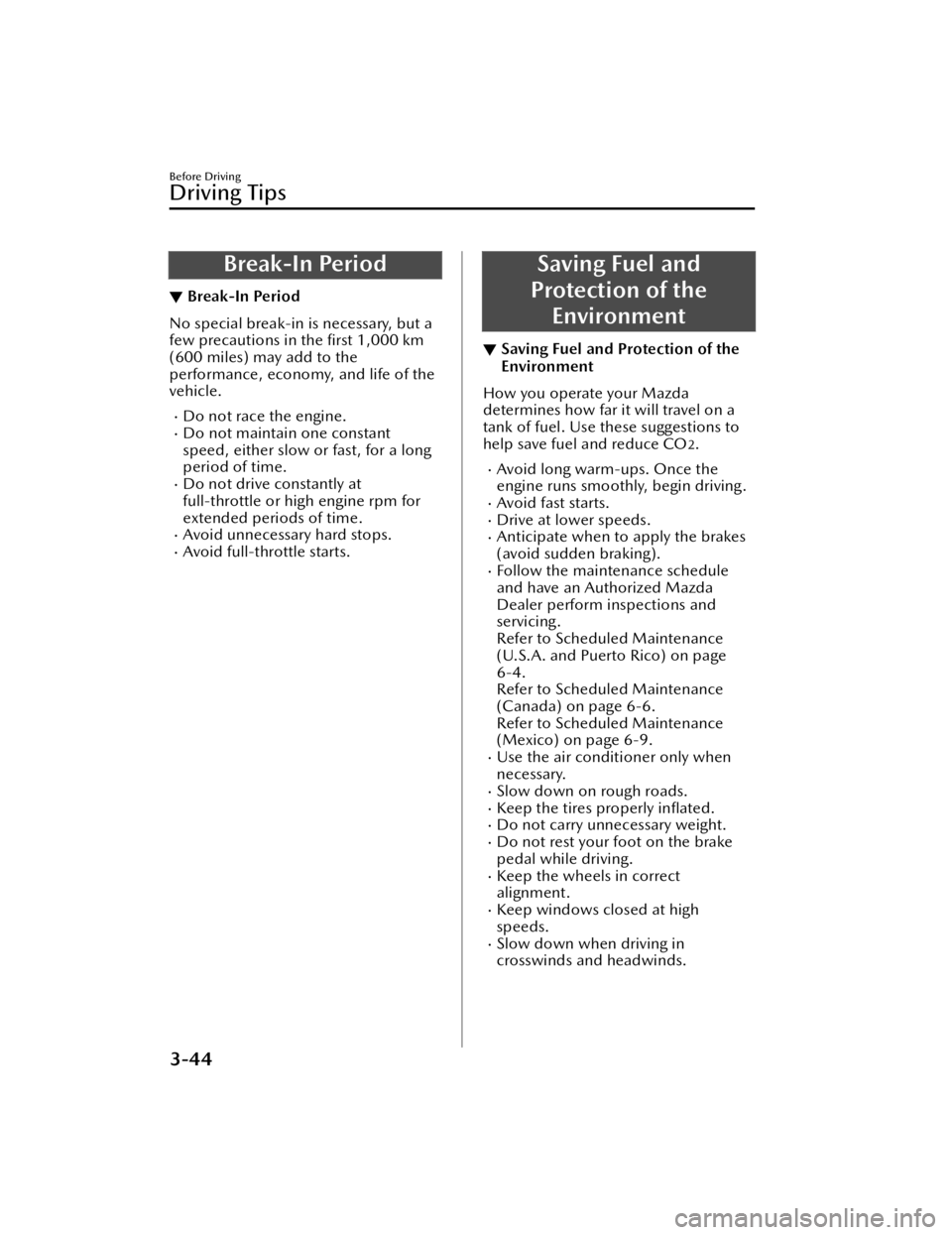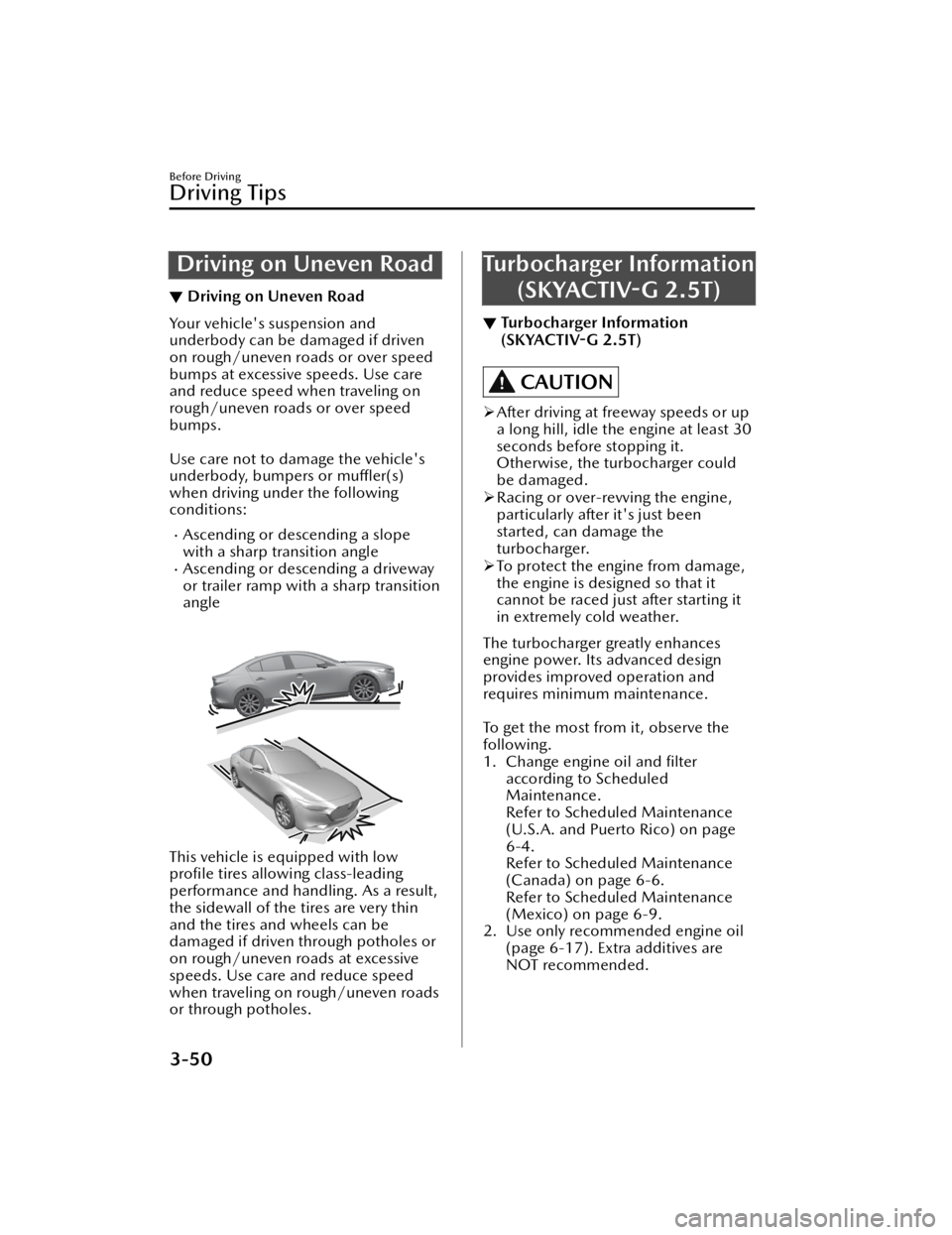tires MAZDA MODEL 3 HATCHBACK 2021 Owners Manual
[x] Cancel search | Manufacturer: MAZDA, Model Year: 2021, Model line: MODEL 3 HATCHBACK, Model: MAZDA MODEL 3 HATCHBACK 2021Pages: 612, PDF Size: 89.06 MB
Page 72 of 612

Do not place any objects on the
assist grips. Only hang clothes
directly on the coat hooks.
Do not touch the components of the
supplemental restraint system after
the air bags have in flated:
Touching the components of the
supplemental restraint system after the
air bags have infl ated is dangerous.
Immediately after inflation, they are
very hot. You could get burned.
Never install any front-end equipment
to your vehicle:
Installation of front-end equipment,
such as frontal protection bar
(kangaroo bar, bull bar, push bar, or
other similar devices), snowplow, or
winches, is dangerous. The air bag
crash sensor system could be a ffected.
This could cause air bags to inflate
unexpectedly, or it could prevent the
air bags from inflating during an
accident. Front occupants could be
seriously injured.
Do not modify the suspension:
Modifying the vehi cle suspension is
dangerous. If the vehicle's height or
the suspension is modi fied, the vehicle
will be unable to accurately detect a
collision or roll-over accident resulting
in incorrect or unexpected air bag
deployment and the possibility of
serious injuries.To prevent false detection by the air
bag sensor system, heed the
following:
Do not use tires or wheels other than
those speci fied for your Mazda:
Use of any tire or wheel other than
those specified for your Mazda (page
9-10) is dangerous. Use of such
wheels will prevent the vehicle's
accident detections system from
accurately detecting a collision or
roll-over accident resulting in
incorrect or unexpected air bag
deployment and the possibility of
serious injuries.
Do not overload your vehicle:
Overloading your vehicle is
dangerous as it could prevent the air
bag crash sensor system from
accurately detecting a collision or
roll-over accident resulting in
incorrect or unexpected air bag
deployment and the possibility of
serious injuries. The gross axle
weight rating (GAWR) and the gross
vehicle weight rating (GVWR) for
your vehicle are on the Motor
Vehicle Safety Standard Label on the
driver's door frame. Do not exceed
these ratings.
Do not drive the vehicle o ff-road:
Driving your Mazda off-road is
dangerous because the vehicle has
not been designed to do so. Driving
the vehicle o ff-road could prevent
the air bag crash sensor system from
accurately detecting a collision or
roll-over accident resulting in
incorrect or unexpected air bag
deployment and the possibility of
serious injuries.
Essential Safety Equipment
SRS Air Bags
2-58
Mazda3_8JM2-EA -20H_Edition1_new 2020-7-10 17:21:34
Page 134 of 612

Break-In Period
▼Break-In Period
No special break-in is necessary, but a
few precautions in the
first 1,000 km
(600 miles) may add to the
performance, economy, and life of the
vehicle.
Do not race the engine.Do not maintain one constant
speed, either slow or fast, for a long
period of time.
Do not drive constantly at
full-throttle or high engine rpm for
extended periods of time.
Avoid unnecessary hard stops.Avoid full-throttle starts.
Saving Fuel and
Protection of the Environment
▼ Saving Fuel and Protection of the
Environment
How you operate your Mazda
determines how far it will travel on a
tank of fuel. Use these suggestions to
help save fuel and reduce CO
2.
Avoid long warm-ups. Once the
engine runs smoothly, begin driving.
Avoid fast starts.Drive at lower speeds.Anticipate when to apply the brakes
(avoid sudden braking).
Follow the maintenance schedule
and have an Authorized Mazda
Dealer perform inspections and
servicing.
Refer to Scheduled Maintenance
(U.S.A. and Puerto Rico) on page
6-4.
Refer to Scheduled Maintenance
(Canada) on page 6-6.
Refer to Scheduled Maintenance
(Mexico) on page 6-9.
Use the air conditioner only when
necessary.
Slow down on rough roads.Keep the tires properly in
flated.Do not carry unnecessary weight.Do not rest your foot on the brake
pedal while driving.
Keep the wheels in correct
alignment.
Keep windows closed at high
speeds.
Slow down when driving in
crosswinds and headwinds.
Before Driving
Driving Tips
3-44
Mazda3_8JM2-EA -20H_Edition1_new 2020-7-10 17:21:34
Page 135 of 612

WARNING
Never stop the engine when going
down a hill:
Stopping the engine when going down
a hill is dangerous. This causes the loss
of power steering and power brake
control, and may cause damage to the
drivetrain. Any loss of steering or
braking control could cause an
accident.
Hazardous Driving
▼Hazardous Driving
WARNING
Be extremely careful if it is necessary
to downshift on slippery surfaces:
Downshifting into lower gear while
driving on slippery surfaces is
dangerous. The sudden change in tire
speed could cause the tires to skid.
This could lead to loss of vehicle
control and an accident.
When driving on ice or in water, snow,
mud, sand, or similar hazards:
Be cautious and allow extra distance
for braking.
Avoid sudden braking and sudden
maneuvering.
Do not pump the brakes. Continue
to press down on the brake pedal.
Refer to Antilock Brake System (ABS)
on page 4-77.
If you get stuck, select a lower gear
and accelerate slowly. Do not spin
the front wheels.
For more traction in starting on
slippery surfaces such as ice or
packed snow, use sand, rock salt,
chains, carpeting , or other nonslip
material under the front wheels.
NOTE
Use snow chains only on the front
wheels.
Before Driving
Driving Tips
3-45
Mazda3_8JM2-EA
-20H_Edition1_new 2020-7-10 17:21:34
Page 137 of 612

Winter Driving
▼Winter Driving
Carry emergency gear, including tire
chains, window scraper,
flares, a small
shovel, jumper cables, and a small bag
of sand or salt.
Ask an Authorized Mazda Dealer to
check the following:
Have the proper ratio of antifreeze in
the radiator.
Refer to Engine Coolant on page
6-20.
Inspect the battery and its cables.
Cold reduces battery capacity.
Use an engine oil appropriate for the
lowest ambient temperatures that
the vehicle will be driven in (page
6-17).
Inspect the ignition system for
damage and loose connections.
Use washer fluid made with
antifreeze ―but do not use engine
coolant antifreeze for washer fluid
(page 6-22).
NOTE
Remove snow before driving. Snow
left on the windshield is dangerous
as it could obstruct vision.
Do not apply excessive force to a
window scraper when removing ice
or frozen snow on the mirror glass
and windshield.
Never use warm or hot water for
removing snow or ice from windows
and mirrors as it could result in the
glass cracking.
Drive slowly. Braking performance
can be adversely a ffected if snow or
ice adheres to the brake
components. If this situation occurs,
drive the vehicle slowly, releasing the
accelerator pedal and lightly applying
the brakes several times until the
brake performance returns to
normal.
▼ Snow Tires
Use snow tires on all 4 wheels
Do not go faster than 120 km/h (75
mph) while driving with snow tires.
In
flate snow tires 30 kPa (0.3 kgf/cm
2,
4.3 psi) more than recommended on
the tire pressure label (driver's door
frame), but never more than the
maximum cold-tire pressure shown on
the tires.
Mexico
The vehicle is originally equipped with
summer tires designed for optimum
traction on wet and dry roads. If your
vehicle is to be used on snow and ice
covered roads, Mazda recommends
that you replace the tires originally
equipped on your vehicle with snow
tires during the winter months.
Except Mexico
The vehicle is originally equipped with
all season radials designed to be used
all year around. In some extreme
climates you may find it necessary to
replace them with snow tires during
the winter months to further improve
traction on snow and ice covered
roads.
Before Driving
Driving Tips
3-47
Mazda3_8JM2-EA -20H_Edition1_new 2020-7-10 17:21:34
Page 138 of 612

WARNING
Use only the same size and type tires
(snow, radial, or non-radial) on all 4
wheels:
Using tires different in size or type is
dangerous. Your vehicle's handling
could be greatly a ffected and result in
an accident.
CAUTION
Check local regulations before using
studded tires.
NOTE
The tire pressure monitoring system
may not function correctly when using
tires with steel wire reinforcement in
the sidewalls (page 4-220).
▼ Tire Chains
Check local regulations before using
tire chains.
CAUTION
Chains may a ffect handling.
Do not go faster than 50 km/h (30
mph) or the chain manufacturer's
recommended limit, whichever is
lower.
Drive carefully and avoid bumps,
holes, and sharp turns.
Avoid locked-wheel braking.
Do not use chains on a temporary
spare tire; it may result in damage to
the vehicle and to the tire.
Do not use chains on roads that are
free of snow or ice. The tires and
chains could be damaged.
Chains may scratch or chip
aluminum wheels.
NOTE
The tire pressure monitoring system
may not function correctly when
using tire chains.
Install the chains on the front tires only.
Do not use chains on the rear tires.
Please consult an Authorized Mazda
Dealer.
Installing the chains
1. If your vehicle is equipped with wheel covers remove them,
otherwise the chain bands will
scratch them.
2. Secure the chains on the front tires as tightly as possible.
Always follow the chain
manufacturer's instructions.
3. Retighten the chains after driving 1/2 ―1 km (1/4 ―1/2 mile).
Before Driving
Driving Tips
3-48
Mazda3_8JM2-EA -20H_Edition1_new 2020-7-10 17:21:34
Page 140 of 612

Driving on Uneven Road
▼Driving on Uneven Road
Your vehicle's suspension and
underbody can be damaged if driven
on rough/uneven roads or over speed
bumps at excessive speeds. Use care
and reduce speed when traveling on
rough/uneven roads or over speed
bumps.
Use care not to damage the vehicle's
underbody, bumpers or
muffler(s)
when driving under the following
conditions:
Ascending or descending a slope
with a sharp transition angle
Ascending or descending a driveway
or trailer ramp with a sharp transition
angle
This vehicle is equipped with low
pro file tires allowing class-leading
performance and handling. As a result,
the sidewall of the tires are very thin
and the tires and wheels can be
damaged if driven through potholes or
on rough/uneven roads at excessive
speeds. Use care and reduce speed
when traveling on rough/uneven roads
or through potholes.
Turbocharger Information
(SKYACTIV -G 2.5T)
▼ Turbocharger Information
(SKYACTIV
-G 2.5T)
CAUTION
After driving at freeway speeds or up
a long hill, idle the engine at least 30
seconds before stopping it.
Otherwise, the turbocharger could
be damaged.
Racing or over-revving the engine,
particularly after it's just been
started, can damage the
turbocharger.
To protect the engine from damage,
the engine is designed so that it
cannot be raced just after starting it
in extremely cold weather.
The turbocharger greatly enhances
engine power. Its advanced design
provides improved operation and
requires minimum maintenance.
To get the most from it, observe the
following.
1. Change engine oil and filter
according to Scheduled
Maintenance.
Refer to Scheduled Maintenance
(U.S.A. and Puerto Rico) on page
6-4.
Refer to Scheduled Maintenance
(Canada) on page 6-6.
Refer to Scheduled Maintenance
(Mexico) on page 6-9.
2. Use only recommended engine oil (page 6-17). Extra additives are
NOT recommended.
Before Driving
Driving Tips
3-50
Mazda3_8JM2-EA -20H_Edition1_new 2020-7-10 17:21:34
Page 175 of 612

Manual TransmissionShift Pattern
▼Manual Transmission Shift Pattern
1. Neutral position
The shift pattern of the transmission is
conventional, as shown.
Depress the clutch pedal all the way
down while shifting; then release it
slowly.
Your vehicle is equipped with a device
to prevent shifting to R (reverse) by
mistake. Push the shift lever downward
and shift to R.
WARNING
Do not use sudden engine braking on
slippery road surfaces or at high
speeds:
Shifting down while driving on wet,
snowy, or frozen roads, or while
driving at high speeds causes sudden
engine braking , which is dangerous.
The sudden change in tire speed could
cause the tires to skid. This could lead
to loss of vehicle control and an
accident.
Always leave the shift lever in 1 or R
position and set the parking brake
when leaving the vehicle unattended:
Otherwise the vehicle could move and
cause an accident.
CAUTION
Keep your foot o ff the clutch pedal
except when shifting gears. Also, do
not use the clutch to hold the vehicle
on an upgrade. Riding the clutch will
cause needless clutch wear and
damage.
Do not apply any excessive lateral
force to the shift lever when
changing from 5th to 4th gear. This
could lead to the accidental
selection of 2nd gear, which could
result in damage to the transmission.
Make sure the vehicle comes to a
complete stop before shifting to R.
Shifting to R while the vehicle is still
moving may damage the
transmission.
NOTE
If shifting to R is
difficult, shift back
into neutral, release the clutch pedal,
and try again.
When Driving
Manual Transmission Operation
4-33
Mazda3_8JM2-EA -20H_Edition1_new 2020-7-10 17:21:34
Page 183 of 612

WARNING
Do not use engine braking on slippery
road surfaces or at high speeds:
Shifting down while driving on wet,
snowy, or frozen roads, or while
driving at high speeds causes sudden
engine braking, which is dangerous.
The sudden change in tire speed could
cause the tires to skid. This could lead
to loss of vehicle control and an
accident.
Keep your hands on the steering
wheel rim when using fingers on the
steering shift switches:
Putting your hands inside the rim of
the steering wheel when using the
steering shift switches is dangerous. If
the driver's air bag were to deploy in a
collision, your hands could be
impacted causing injury.
NOTE
When driving at high speeds, the
gear may not shift down.
During deceleration, the gear may
automatically shift down depending
on vehicle speed.
When depressing the accelerator
fully, the transmission will shift to a
lower gear, depending on vehicle
speed. However, the gears do not
kickdown while the DSC is turned
o ff.
▼ Second Gear Fixed Mode
When the selector lever is moved back
+ while the vehicle speed is about 10
km/h (6.2 mph) or less, the
transmission is set in the second gear
fixed mode. The gear is
fixed in second
while in this mode for easier
acceleration from a stop and driving on
slippery roads such as snow-covered
roads.
If the selector lever is moved back + or
forward – while in the second gear
fixed mode, the mode will be
canceled.
When Driving
Automatic Transmission
4-41
Mazda3_8JM2-EA -20H_Edition1_new 2020-7-10 17:21:34
Page 209 of 612

If there is a problem with the brake
system (foot brake) while driving the
vehicle, continually pulling up the
EPB switch will apply the brakes and
decelerate or stop the vehicle. The
parking brake on-reminder sound is
activated while the brake is applied.
In addition, when releasing the
switch, the brake is released and the
sound stops.
If the parking brake is applied with
the ignition switched OFF or in ACC,
the EPB indicator light in the
instrument cluster and the indicator
light in the switch may turn on for 15
seconds.
When using an automatic car wash
which moves the vehicle with the
front tires mounted, it is necessary to
cancel the parking brake auto
operation before the vehicle enters
the automatic car wash. For details,
refer to Canceling the parking brake
automatic operation.
Manual operation
Applying the parking brake manually
When the brake pedal is firmly
depressed and the EPB switch is pulled
up, the parking brake is applied
regardless of the ignition position.
When the parking brake is applied, the
EPB indicator light in the instrument
cluster and the EPB switch indicator
light turn on.
Releasing the parking brake manually
When the brake pedal is firmly
depressed and the EPB switch is
pressed while the ignition is switched
ON or the engine is running, the
parking brake is released. When the
parking brake is released, the EPB
indicator light in the instrument cluster
and the EPB switch indicator light turn
o ff.
If the EPB switch is pressed without
depressing the brake pedal, a message
is displayed on the multi-information
display to notify the driver to depress
the brake pedal.
Refer to Message Indicated on
Multi-information Display on page
7-39.
Auto operation
Applying the parking brake
automatically
When the ignition is switched from ON
to ACC or OFF, the parking brake will
be applied automatically. When the
parking brake is applied, the EPB
indicator light in the instrument cluster
and the EPB switch indicator light turn
on.
When Driving
Brake
4-67
Mazda3_8JM2-EA -20H_Edition1_new 2020-7-10 17:21:34
Page 219 of 612

Antilock Brake System(ABS)
▼Antilock Brake System (ABS)
The ABS control unit continuously
monitors the speed of each wheel. If
one wheel is about to lock up, the ABS
responds by automatically releasing
and reapplying that wheel's brake.
The driver will feel a slight vibration in
the brake pedal and may hear a
chattering noise from the brake system.
This is normal ABS system operation.
Continue to depress the brake pedal
without pumping the brakes.
The warning light turns on when the
system has a malfunction.
Refer to ABS Warning Indication/
Warning Light on page 7-30.
WARNING
Do not rely on ABS as a substitute for
safe driving:
The ABS cannot compensate for unsafe
and reckless driving , excessive speed,
tailgating (following another vehicle
too closely), driving on ice and snow,
and hydroplaning (reduced tire friction
and road contact because of water on
the road surface). You can still have an
accident.
NOTE
Braking distances may be longer on
loose surfaces (snow or gravel, for
example) which usually have a hard
foundation. A vehicle with a normal
braking system may require less
distance to stop under these
conditions because the tires will
build up a wedge of surface layer
when the wheels skid.
The sound of the ABS operating may
be heard when starting the engine or
immediately after starting the
vehicle, however, it does not indicate
a malfunction.
When Driving
ABS/TCS/DSC
4-77
Mazda3_8JM2-EA
-20H_Edition1_new 2020-7-10 17:21:34